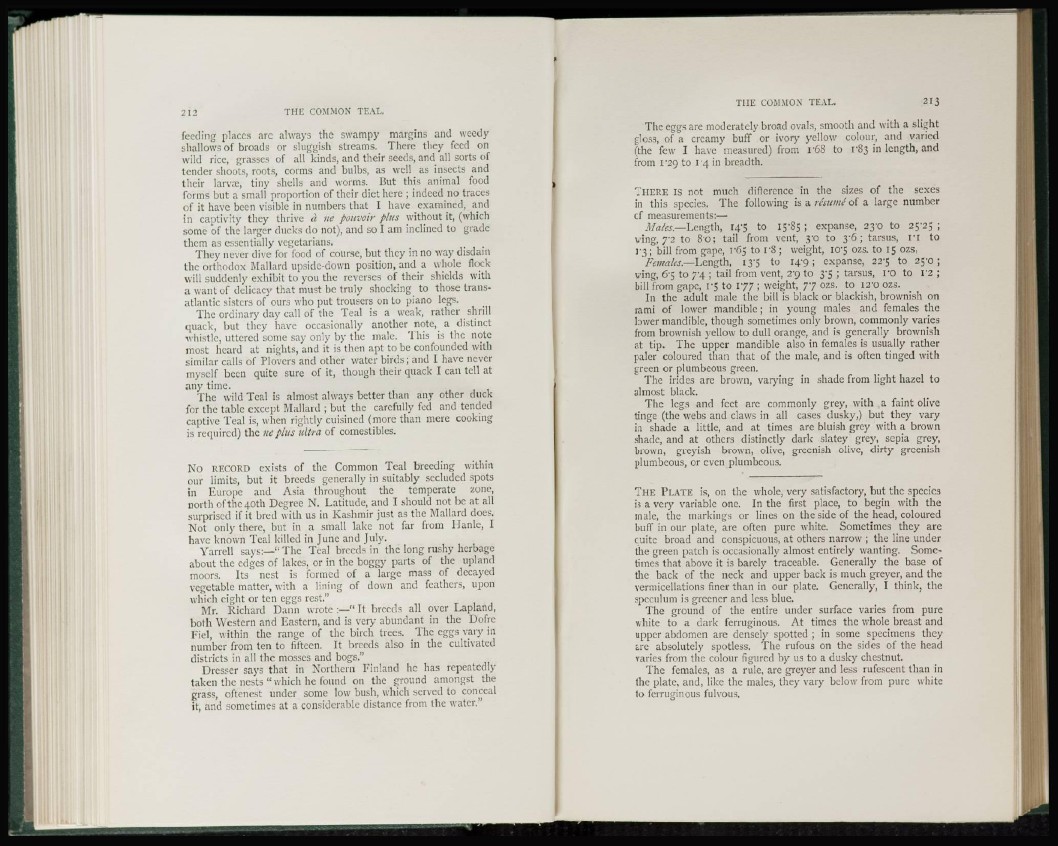
2 1 2 THE COMMON TEAL.
feeding places arc always the swampy margins and weedy
shallows of broads or sluggish streams. There they feed on
wild rice, grasses of all kinds, and their seeds, and all sorts of
tender shoots, roots, corms and bulbs, as well as insects and
their larva;, tiny shells and worms. Hut this animal food
forms but a small proportion of their diet here ; indeed no traces
of it have been visible in numbers that I have examined, and
in captivity they thrive a ne pouvoir plus without it, (which
some of the larger ducks do not), and so I am inclined to grade
them as essentially vegetarians.
They never dive for food of course, but they in no way disdain
the orthodox Mallard upside-down position, and a whole flock
will suddenly exhibit to you the reverses of their shields with
a want of delicacy that must be truly shocking to those transatlantic
sisters of ours who put trousers on to piano legs.
The ordinary day call of the Teal is a weak, rather shrill
quack, but they have occasionally another note, a distinct
whistle, uttered some say only by the male. This is the note
most heard at nights, and it is then apt to be confounded with
similar calls of Plovers and other water birds; and I have never
myself been quite sure of it, though their quack I can tell at
any time.
The wild Teal is almost always better than any other duck
for the table except Mallard ; but the carefully fed and tended
captive Teal is, when rightly cuisincd (more than mere cooking
is required) the ne plus ultra of comestibles.
No RECORD exists of the Common Teal breeding within
our limits, but it breeds generally in suitably secluded spots
in Europe and Asia throughout the temperate zone,
north of the 40th Degree N. Latitude, and I should not be at all
surprised if it bred with us in Kashmir just as the Mallard docs.
Not only there, but in a small lake not far from Hanle, I
have known Teal killed in June and July.
Yarrell says:—" The Teal breeds in the long rushy herbage
about the edges of lakes, or in the boggy parts of the upland
moors. Its nest is formed of a large mass of decayed
vegetable matter, with a lining of down and feathers, upon
which eight or ten eggs rest."
Mr. Richard Dann wrote :—" It breeds all over Lapland,
both Western and Eastern, and is very abundant in the Dofre
Fiel, within the range of the birch trees. The eggs vary in
number from ten to fifteen. It breeds also in the cultivated
districts in all the mosses and bogs."
Dresser says that in Northern Finland he has repeatedly
taken the nests " which he found on the ground amongst the
grass, oftenest under some low bush, which served to conceal
it, and sometimes at a considerable distance from the water."
THE COMMON TEAL. 213
The eggs are moderately broad ovals, smooth and with a slight
gloss, of a creamy buff or ivory yellow colour, and varied
(the few I have measured) from r6S to 1-83 in length, and
from 1 "29 to 1 4 in breadth.
THERE IS not much difference in the sizes of the sexes
in this species. The following is a résumé of a large number
of measurements:—•
Males.—Length, I4'5 to 15-Ss ; expanse, 230 to 25-25 ;
wing, 7*2 to 80; tail from vent, 3*0 to 3'6 ; tarsus, ri to
1 3 ; bill from gape, 1 '65 to I'8 ; weight, I0'5 ozs. to 15 ozs.
Females.—Length, 13-5 to 14-9; expanse, 22-5 to 25-0;
wing, 65 to 74 ; taii from vent, 2-9 to 3-5 ; tarsus, i-o to I'2 ;
bill from gape, !•$ to 177 ; weight, 77 ozs. to i2-o ozs.
In the adult male the bill is black or blackish, brownish on
rami of lower mandible ; in young males and females the
lower mandible, though sometimes only brown, commonly varies
from brownish yellow to dull orange, and is generally brownish
at tip. The upper mandible also in females is usually rather
paler coloured than that of the male, and is often tinged with
green or plumbeous green.
The irides are brown, varying in shade from light hazel to
almost black.
The legs and feet are commonly grey, with a faint olive
tinge (the webs and claws in all cases dusky,) but they vary
in shade a little, and at times are bluish grey with a brown
shade, and at others distinctly dark slatey grey, sepia grey,
brown, greyish brown, olive, greenish olive, dirty greenish
plumbeous, or even plumbeous.
THE PLATE is, on the whole, very satisfactory, but the species
is a very variable one. In the first place, to begin with the
male, the markings or lines on the side of the head, coloured
buff in our plate, are often pure white. Sometimes they are
quite broad and conspicuous, at others narrow ; the line under
the green patch is occasionally almost entirely wanting. Sometimes
that above it is barely traceable. Generally the base of
the back of the neck and upper back is much greyer, and the
vcrmicellations finer than in our plate. Generally, I think, the
speculum is greener and less blue.
The ground of the entire under surface varies from pure
white to a dark ferruginous. At times the whole breast and
upper abdomen arc densely spotted ; in some specimens they
are absolutely spotless. The rufous on the sides of the head
varies from the colour figured by us to a dusky chestnut.
The females, as a rule, are greyer and less rufescent than in
the plate, and, like the males, they vary below from pure white
to ferruginous fulvous.